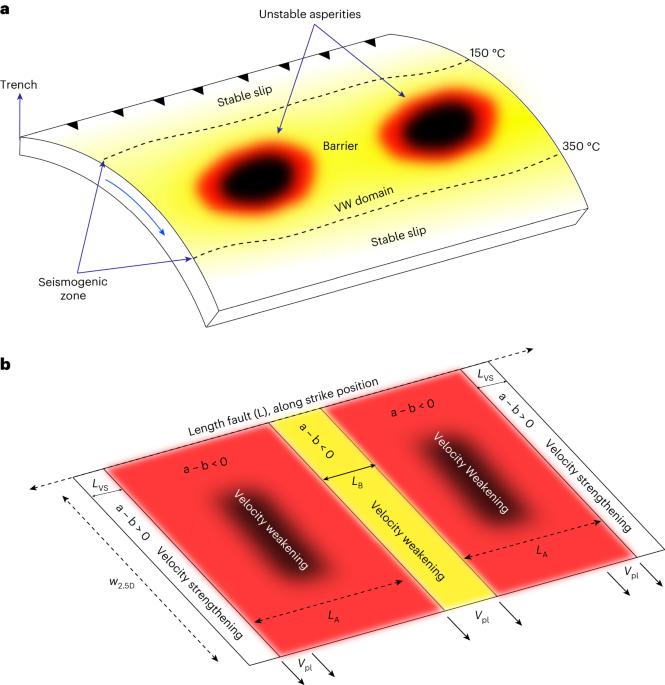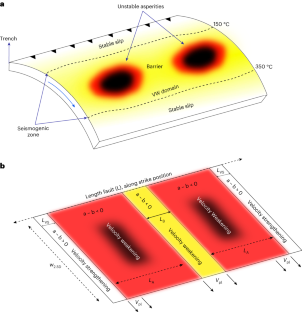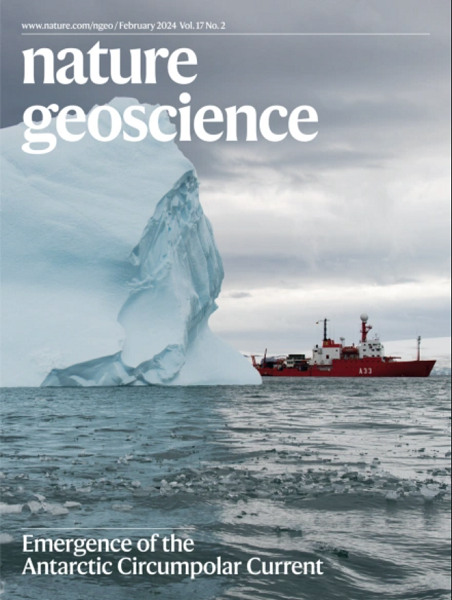Diverse slip behaviour of velocity-weakening fault barriers
IF 15.7
1区 地球科学
Q1 GEOSCIENCES, MULTIDISCIPLINARY
引用次数: 0
Abstract
Seismic barriers are fault portions that promote earthquake rupture arrest and fault segmentation. Despite their fundamental role in controlling the maximum magnitude of earthquakes, the nature of seismic barriers is still uncertain. A common interpretation of barriers as having velocity-strengthening friction—steady-state friction that increases with increasing slip velocity—is only partially consistent with the thermal control of friction observed in laboratory experiments, which implies that most relevant materials in subduction channels are velocity-weakening at seismogenic depths. Here we examine the possibility of velocity-weakening barriers by conducting earthquake cycle simulations along a velocity-weakening megathrust segmented by lateral variations of frictional properties and normal stress. We show that velocity-weakening fault segments display a wide range of behaviours, including permanent barrier behaviour. They can be locked during long periods and release their slip deficit either seismically or aseismically. We quantify the efficiency of velocity-weakening barriers in arresting ruptures using a non-dimensional parameter based on fracture mechanics theory that can be constrained by observations on natural faults. Our results provide a theoretical framework that could improve physics-based seismic hazard assessment. Velocity-weakening seismic barriers in subduction zones display a range of behaviours consistent with geologic structural control on earthquake seismicity, according to earthquake cycle simulations along a megathrust.


速度弱化断层屏障的不同滑动行为
地震屏障是促进地震破裂停止和断层分割的断层部分。尽管它们在控制最大地震震级方面发挥着根本作用,但地震屏障的性质仍然不确定。通常将屏障解释为具有速度增强摩擦——随着滑动速度的增加而增加的稳态摩擦——与实验室实验中观察到的摩擦的热控制仅部分一致,这意味着俯冲通道中的大多数相关材料在发震深度都是速度减弱的。在这里,我们通过沿着由摩擦特性和法向应力的横向变化划分的速度减弱大推力进行地震循环模拟,来检验速度减弱屏障的可能性。我们表明,速度弱化断层段表现出广泛的行为,包括永久屏障行为。它们可以在很长一段时间内被锁定,并通过地震或地震释放其滑动不足。我们使用基于断裂力学理论的无量纲参数来量化速度削弱屏障在阻止断裂中的效率,该参数可以受到自然断层观测的约束。我们的研究结果提供了一个理论框架,可以改进基于物理的地震危险性评估。
本文章由计算机程序翻译,如有差异,请以英文原文为准。
求助全文
约1分钟内获得全文
求助全文
来源期刊

Nature Geoscience
地学-地球科学综合
CiteScore
26.70
自引率
1.60%
发文量
187
审稿时长
3.3 months
期刊介绍:
Nature Geoscience is a monthly interdisciplinary journal that gathers top-tier research spanning Earth Sciences and related fields.
The journal covers all geoscience disciplines, including fieldwork, modeling, and theoretical studies.
Topics include atmospheric science, biogeochemistry, climate science, geobiology, geochemistry, geoinformatics, remote sensing, geology, geomagnetism, paleomagnetism, geomorphology, geophysics, glaciology, hydrology, limnology, mineralogy, oceanography, paleontology, paleoclimatology, paleoceanography, petrology, planetary science, seismology, space physics, tectonics, and volcanology.
Nature Geoscience upholds its commitment to publishing significant, high-quality Earth Sciences research through fair, rapid, and rigorous peer review, overseen by a team of full-time professional editors.
 求助内容:
求助内容: 应助结果提醒方式:
应助结果提醒方式:


